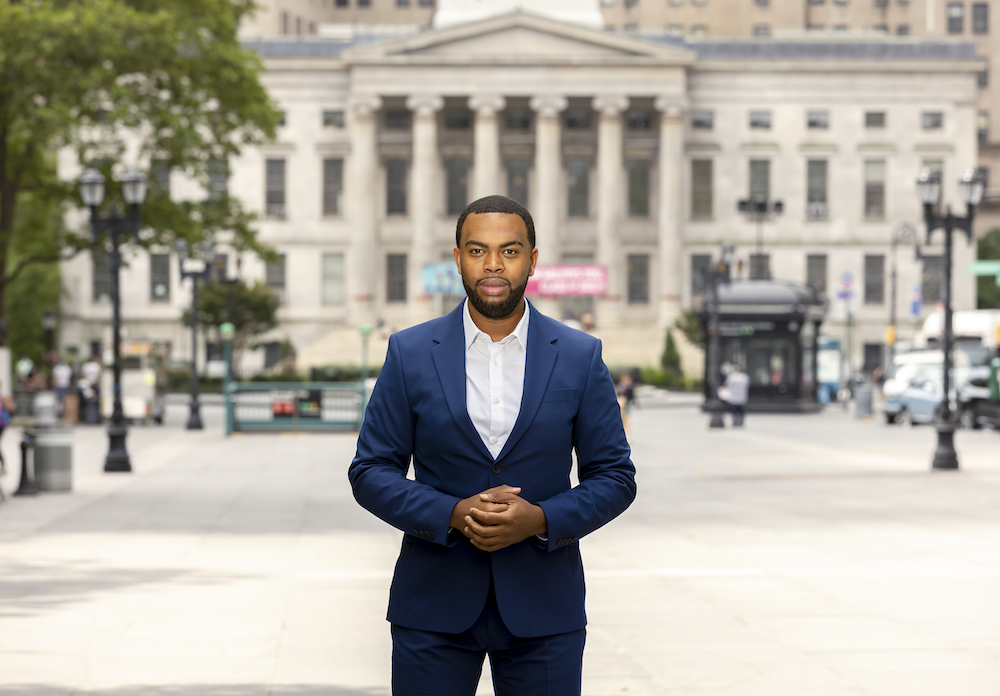Last year was one for the books and amidst the upset of daily life, caused by the pandemic and civil unrest due to police brutality, journalists were there to keep the public informed in uncertain times. News 12 Brooklyn reporter Phil Taitt was in the eye of the storm when covering tragedies and the global health crisis that brought the world to a standstill.
He lends his expertise and insight in a conversation with The Quintessential Gentleman on reporting news stories in dark times, and the unique challenges that arise as an African American journalist.
When reflecting on the challenges of reporting a news story that must be presented objectively to audiences, and remaining grounded throughout daily experiences as a man of color, Taitt said, “I stay grounded first as a Black man by choosing to live my life with integrity and a life filled with purpose. By doing that, I can face any issue, obstacle, or challenge with clarity and a sound mind. As a journalist, it is not my job to share my opinion. My job is to share the narrative while balancing the story with both viewpoints of how someone may feel on a particular issue.”
After being confronted with sensitive topics such as racial injustice, Taitt chooses to approach these issues by focusing on the facts and gaining opinions from whatever party is willing to share their perspective with him.
“As an example, when the death of George Floyd sparked the largest civil rights movement last summer, it brought about different feelings among many groups of people,” he explains.
“For some people, it was about the brutal death of George Floyd that was captured on video by now-convicted former Minneapolis police officer Derek Chauvin who knelt on Floyd’s neck for nine minutes and twenty-nine seconds. For others, it was about focusing on an issue that they say had gone on for too long; the issue that Black and Brown communities continually face dying at the hands of police. I document these feelings as accurately conveyed to me along with the changes these people want to see, which is a call for social justice through police reform and accountability.”

According to Taitt, after the death of George Floyd, hundreds of protestors poured into Brooklyn’s streets to march. Filled with outrage by such a horrific event, protestors traveled throughout the city from the Brooklyn Bridge and beyond. He remembers his first assignment after Floyd’s death with great clarity.
“On this particular night, shortly after the death of Floyd, there was such an intensity in the atmosphere,” he recalls.
“I can still hear today protestors crying, yelling, and screaming as they stood face to face with police officers who had on their helmets and carried their batons. There were constant scuffles with police, with multiple people being arrested at times, some within minutes. Many times, while I was out there, I thought to myself, we read about the Civil Rights movement and other movements in our textbooks but I never thought I’d live to see a movement that would become the summer of all protests.”
Taitt admitted that remaining neutral when covering new stories after the deaths of George Floyd, Breonna Taylor, and Ahmaud Arbery was important, although a person of color.
“It was tough as I reflected on myself as a person,” he said.
“I am not just a Black reporter. I’m a Black man. When I would ask people from the Black and Brown communities to speak with me and share their opinions, I would, at times, be asked, ‘ain’t you Black?’ or ‘you know what we are talking about, right?’ But as a reporter, my job wasn’t to share my opinion. It was to share theirs! Each day I buried my feelings to be able to do my job. Just as I do with any other story, regardless of the issue. Of course, certain topics hit closer to home than others. I was thankful when many people reached out to me, from my community and beyond, and said, ‘Phil… Thank you for being out here. Thank you for telling this story and getting it right. We appreciate you.’ While each day was not easy being out there, I rested in the fact that I was a Black journalist able to report in such a time as this.”
The civil unrest sparked by displays of racial injustice wasn’t the only problem he would face. In March of 2020, Taitt encountered an unforeseen challenge that came in the form of the current pandemic. Reporting on Governor Cuomo’s executive order that all restaurants would be limited to delivery and take-out services was his first news story in the covid era.
Like restaurants and other businesses, the newscast was also affected by covid and had to maneuver around the problem. Wearing masks and standing six feet apart were only a few of the ways journalists learned to adapt to the present health crisis.
“Pre-pandemic, I was always going to meet someone for an interview but in-person interviews became very few, turning to virtual platforms using Zoom,” he stated.
“While this effort limited exposure from having contact with another person, it also allowed me to meet multiple people quickly. Instead of having to interview two to three people for one story in three different places, I was able to sit at my laptop and interview many in just minutes.”
Amidst the turmoil of 2020, many have experienced trauma in one form or another. As a journalist being in the thick of things puts Taitt in a unique but also challenging position.
“I witnessed hospitals overwhelmed, schools turning to virtual measures, restaurants trying to stay open, unemployment at record rates, and the death toll rising by the day,” he remembers.
“There was an immense sadness around even while protestors were taking to the streets rallying for change each day, stemming from the death of George Floyd. As a journalist, my job was not to be vulnerable. It was to give a voice to those who needed to be heard. I will say that with prayer, a supportive family, and friends, I was able to work through it.”
If assigned a controversial topic as an up-and-coming journalist, Taitt advises avoiding implementing personal bias, encourages focusing on the facts, and relying on sources directly connected to an issue.
Photo Credits: Jonathan Rodriguez
Check out our Culture Issue.





